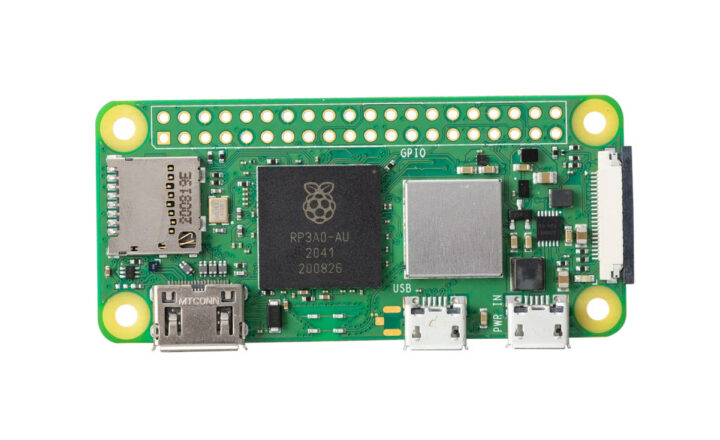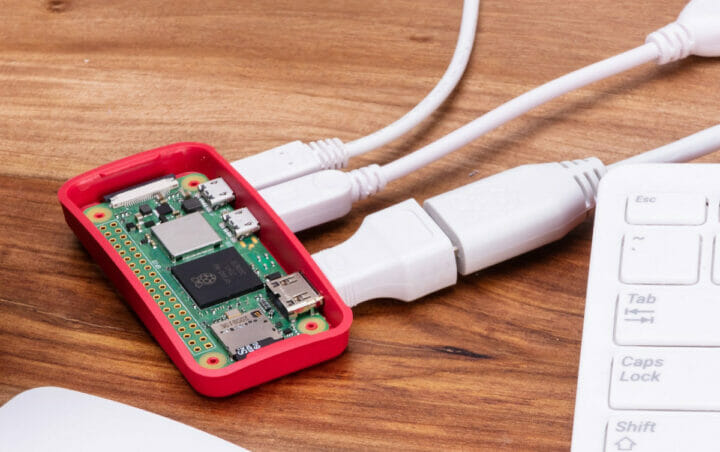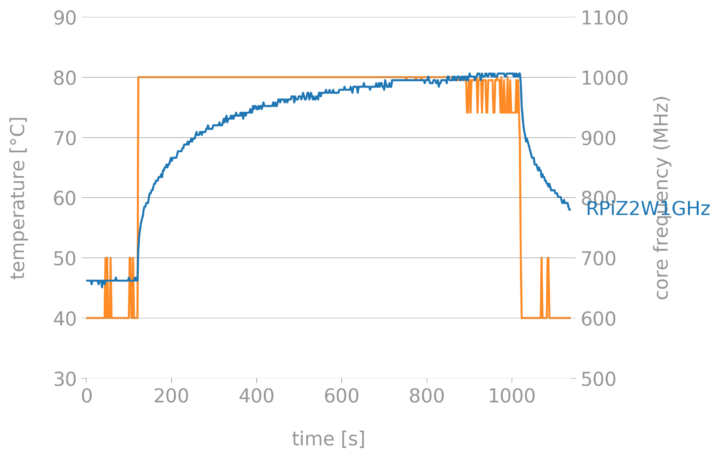Raspberry Pi Zero 2 W is the first quad-core SBC from the Raspberry Pi Foundation with the Raspberry Pi Zero form factor. Based on the RP3A0 system-in-package (SiP) comprised of a Broadcom BCM2710A1 quad-core Cortex-A53 processor and 512MB LPDDR2, the new Pi Zero W 2 board offers the exact same interfaces as its predecessor.
This includes a MicroSD card socket, a mini HDMI port, two micro USB ports, a MIPI CSI-2 camera connector, as well as an unpopulated 40-pin GPIO header. The wireless module appears to have changed but still offers WiFi 4 and Bluetooth 4.x BLE, and it’s using the same VideoCore IV GPU to handle 3D graphics and video encoding and decoding up to 1080p30.
 Raspberry Pi Zero 2 W specifications:
Raspberry Pi Zero 2 W specifications:
- SiP – Raspberry Pi RP3A0 system-in-package with:
- SoC – Broadcom BCM2710A1 quad-core Arm Cortex-A53 @ 1GHz (overclockable to 1.2 GHz) with VideoCore IV CPU supporting OpenGL ES 1.1, 2.0 graphics
- Memory – 512MB LPDDR2
- Storage – MicroSD card socket
- Video output – Mini HDMI port, composite video via header
- Camera – MIPI CSI-2 camera connector
- Video
- Decoding – H.264 and MPEG-4 up to 1080p30
- Encoding – H.264 up to 1080p30
- Connectivity – 2.4GHz IEEE 802.11b/g/n Wi-Fi 4 and Bluetooth 4.2 BLE with onboard antenna
- USB – 1x Micro USB 2.0 OTG port
- Expansion – Unpopulated 40-pin HAT-compatible I/O header
- Power Supply – 5V/2.5A via Micro USB port
- Dimensions – 65 x 30 mm (same form factor as previous Raspberry Pi Zero boards)
- Temperature Range – -20°C to +70°C
- Production lifetime – At least until January 2028
 The CPU performance will be much higher than for the Raspberry Pi Zero even with the same 1 GHz CPU clock due to the jump from an ARM11 core to Cortex-A53 cores, and in theory, performance should be about 30% slower than a Raspberry Pi 3 B+ with a processor clocked at 1.4 GHz. The frequency is lower than Raspberry Pi Zero W probably because the board is smaller and cooling is more challenging. So it’s something to test, and I should receive a sample later today, but Cytron already tested the board and throttling does occur when the CPU temperature gets over 80°C even at the 1 GHz stock frequency.
The CPU performance will be much higher than for the Raspberry Pi Zero even with the same 1 GHz CPU clock due to the jump from an ARM11 core to Cortex-A53 cores, and in theory, performance should be about 30% slower than a Raspberry Pi 3 B+ with a processor clocked at 1.4 GHz. The frequency is lower than Raspberry Pi Zero W probably because the board is smaller and cooling is more challenging. So it’s something to test, and I should receive a sample later today, but Cytron already tested the board and throttling does occur when the CPU temperature gets over 80°C even at the 1 GHz stock frequency.

The switch from Broadcom BCM2835 processor to Raspberry Pi BCM2710A1 may also help alleviate the shortage that led to the Raspberry Pi 4 2GB price increase, although both are likely manufactured with a 40nm process.
The power requirements have changed too, as since a 5V/1.5A power adapter was recommended for the Pi Zero W, the Raspberry Pi Foundation upped that to 5V/2.5A for the Pi Zero W 2 while keeping a micro USB port for power. So you’ll have to make sure to use an adequate power adapter and select a good quality Micro USB cable that is as short as convenient to make sure the board works under all conditions. Software support is the same with Raspberry Pi OS and third-party OS such as Ubuntu.
While the Raspberry Pi Zero W 2 is the first quad-core 65 x 30mm board from the Raspberry Pi Foundation, other quad-core boards with Pi Zero form factor had been released by other companies in the past with solutions such as Radxa Zero or Banana Pi BPI-M2 Zero. The launch of Raspberry Pi Zero W 2 basically kills the latter, but Radxa Zero still has some advantages including a faster processor, RAM capacity from 512MB to 4GB, and an optional 802.11ac WiFi 5 and Bluetooth 5.0 wireless module.
Raspberry Pi Zero W 2 is available now for $15 in the US, EU, Canada, and Hong Kong, but I’ve been told stock will come to other countries later due to pending certifications. More details may be found on the product page.

Jean-Luc started CNX Software in 2010 as a part-time endeavor, before quitting his job as a software engineering manager, and starting to write daily news, and reviews full time later in 2011.
Support CNX Software! Donate via cryptocurrencies, become a Patron on Patreon, or purchase goods on Amazon or Aliexpress




